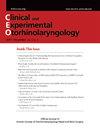Measurement of microplastic release after use of polypropylene nasal irrigation bottles.
IF 3.4
3区 医学
Q1 OTORHINOLARYNGOLOGY
引用次数: 0
Abstract
Objectives Microplastics from plastic materials can affect human health. This study aimed to assess their presence in nasal irrigation fluids obtained from reused bottles based on usage duration. Methods Readily available nasal irrigation bottles made of polypropylene were purchased. Unused irrigation bottles served as controls. Bottles mimicking 1-, 3-, and 6-month reuse were prepared as test samples. Nasal irrigation fluid samples (n=12) were collected from each set of irrigation bottles: three from new control bottles and nine from bottles mimicking 1-, 3-, and 6-month reuse. Raman spectroscopy was employed to detect microplastics in the nasal irrigation samples; the results were compared according to the bottle use duration. Results An average of 33.00±20.42 (ea/300 mL) microplastic particles was detected in the nasal irrigation fluid from the control bottles relative to an average of 68.66±30.07, 261.66±20.59, and 204.33±52.16 (ea/300 mL) from bottles used for 1, 3, and 6 months, respectively. The majority of the detected microplastics were 10-100 μm in size and fragmentshaped in form. The predominant microplastic was polypropylene, indicating direct release from irrigation bottles. Conclusion We found microplastics in nasal irrigation fluids, likely originating from the repeated use of nasal irrigation bottles. The quantity of microplastics was notably elevated in the samples obtained from bottles simulating 3 months of use compared to those in the control samples. Thus, we propose developing guidelines regulating the duration of nasal irrigation bottle usage to mitigate microplastic infiltration into the body through the sinonasal cavity.测量使用聚丙烯鼻腔冲洗瓶后的微塑料释放量。
目的 塑料材料中的微塑料会影响人体健康。本研究旨在根据使用时间的长短,评估从重复使用的瓶子中获得的鼻腔冲洗液中是否含有微塑料。未使用过的冲洗瓶作为对照。模拟重复使用 1 个月、3 个月和 6 个月的瓶子作为测试样本。从每组灌流瓶中收集鼻腔灌流液样本(n=12):3 份来自新的对照瓶,9 份来自模拟重复使用 1、3 和 6 个月的瓶子。结果 在对照瓶的鼻腔灌洗液中平均检测到 33.00±20.42(ea/300 mL)个微塑料颗粒,而在使用 1、3 和 6 个月的瓶子中平均分别检测到 68.66±30.07、261.66±20.59 和 204.33±52.16(ea/300 mL)个微塑料颗粒。检测到的大多数微塑料大小为 10-100 μm,呈碎片状。结论我们在鼻腔冲洗液中发现了微塑料,很可能是反复使用鼻腔冲洗瓶造成的。与对照样本相比,从模拟使用 3 个月的瓶子中提取的样本中的微塑料数量明显增加。因此,我们建议制定规范鼻腔冲洗瓶使用时间的指南,以减少微塑料通过鼻窦腔渗入人体。
本文章由计算机程序翻译,如有差异,请以英文原文为准。
求助全文
约1分钟内获得全文
求助全文
来源期刊
CiteScore
4.90
自引率
6.70%
发文量
49
审稿时长
6-12 weeks
期刊介绍:
Clinical and Experimental Otorhinolaryngology (Clin Exp Otorhinolaryngol, CEO) is an international peer-reviewed journal on recent developments in diagnosis and treatment of otorhinolaryngology-head and neck surgery and dedicated to the advancement of patient care in ear, nose, throat, head, and neck disorders. This journal publishes original articles relating to both clinical and basic researches, reviews, and clinical trials, encompassing the whole topics of otorhinolaryngology-head and neck surgery.
CEO was first issued in 2008 and this journal is published in English four times (the last day of February, May, August, and November) per year by the Korean Society of Otorhinolaryngology-Head and Neck Surgery. The Journal aims at publishing evidence-based, scientifically written articles from different disciplines of otorhinolaryngology field.
The readership contains clinical/basic research into current practice in otorhinolaryngology, audiology, speech pathology, head and neck oncology, plastic and reconstructive surgery. The readers are otolaryngologists, head and neck surgeons and oncologists, audiologists, and speech pathologists.

 求助内容:
求助内容: 应助结果提醒方式:
应助结果提醒方式:


